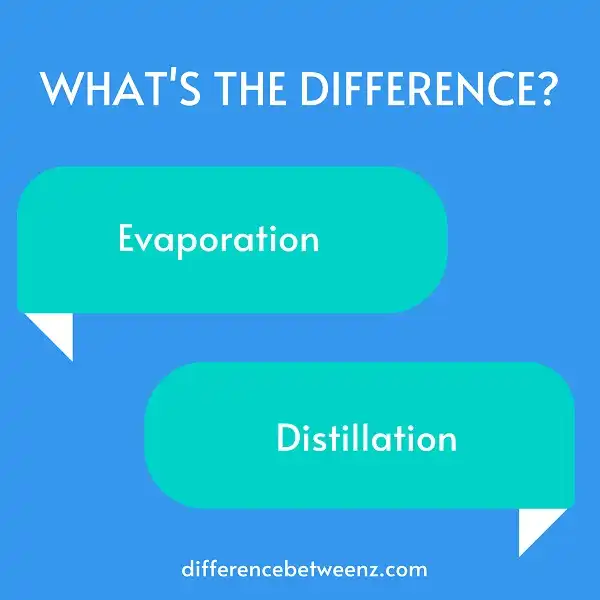Both evaporation and distillation are types of vaporization, but there is a big difference between the two. Evaporation is the process of turning a liquid into a gas, while distillation is the process of purifying a liquid by boiling it and then condensing the vapor to collect the pure liquid. In general, distillation is used to produce high-quality products, while evaporation is used for industrial purposes.
What is Evaporation?
- Evaporation is a type of vaporization that occurs on the surface of a liquid as it changes into the gas phase. The liquid molecules interact with the molecules of the gas phase, and the energy from this interaction causes them to change into gas molecules.
- Evaporation is a cooling process because it requires energy to change the state of the molecules, and this energy is taken from the surrounding environment.
- When Evaporation happens, the temperature of the surrounding environment decreases. Evaporation can be used to cool down overheated liquids, and it is also responsible for the water cycle. Evaporation from oceans, lakes, and rivers provides moisture for the atmosphere which eventually falls back to Earth as precipitation.
What is Distillation?
Distillation is a process of separating the components or substances from a liquid mixture by selective vaporization and condensation. Distillation may result in essentially complete separation (nearly pure components), or it may be a partial separation that increases the concentration of selected components in the mixture.
- In either case, the process exploits differences in the volatility of the mixture’s components. In industrial chemistry, Distillation is a unit operation of practically universal importance, but it is a complex and energy-intensive process. Distillations are often used to separate light fractions (such as naphtha) from heavy fractions (such as gas oil), or vice versa.
- Other important uses include separating Distillates such as ethanol from water and separating an organic compound from impurities and reaction products. Although simple distillations are relatively easy to design, Distillations can be technically challenging due to the numerous controllable variables and opportunities for fouling of equipment.
- Distillation is used to separate liquids based on their boiling points. When a mixture of liquids is heated, each liquid will evaporate at its own boiling point. The vapors are then condensed back into their respective liquids. This process can be used to purify a liquid or to separate mixtures of liquids with different boiling points.
Difference between Evaporation and Distillation
Evaporation is a type of vaporization that occurs on the surface of a liquid as it changes into the gas phase. The energy required for evaporation comes from the surroundings, and it is dependent on various factors, such as temperature and humidity.
- Evaporation is a naturally occurring process that is used in many everyday situations, such as when water evaporates from your skin or when sweat evaporates from your clothes.
- Distillation, on the other hand, is a process that separates liquids based on their different boiling points. In distillation, a liquid is heated until it vaporizes, and the resulting vapor is condensed back into a liquid.
- This process can be used to purify liquids or to separate two or more liquids with different boiling points. Distillation is often used to produce distilled beverages, such as whiskey and vodka. It can also be used to produce essential oils.
Conclusion
Evaporation and distillation are two common methods of separating liquids from solids. Inevitably, there will be some confusion between the two processes. Hopefully, this article has cleared up any misconceptions and you now have a better understanding of each process.


